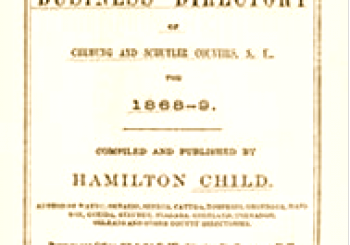Early Schuyler County History

To many to whom the name Schuyler County means little, the mention of Watkins Glen will strike a familiar chord. This famous and much visited canon is one, and only one, of the several fine natural beauties of this central New York county. Before ever a white man had peered into the depths of the glen it was held to be one of the dwelling places of the Great Spirit by the aborigines. His voice they heard in the tumbling waters; His power was seen in the making of the rift; it was the cathedral in which they worship Him.
The returning Sullivan expedition from the punitive trip into the land of the Senecas paused to locate the extraordinary place. Later a number made the long and dangerous journey over the Indian trails to see for themselves this natural wonder, and many stayed, or later returned and made their homes near its brink. To them the shores of Seneca Lake also appealed with its broad acres and means of transportation. There were water powers to be utilized to turn their mills. To those who must wring their very existence from the primitive woods and lands, the natural beauties may attract, but it is the practical utility that leads them to stay.
And so it was with the pioneers of Schuyler County. The Indians had built close to Seneca Lake and Glen one of their largest towns, known as Catherine’s town, after the famous wife of Montour, a more famous chief. It had been utterly destroyed by Sullivan. But the fires of the burning place had not ceased before there were those who planned to rebuild it as a habitation of the whites. It was, however, nine years later when one of the Sullivan soldiers came to the desolated area and made there the first permanent settlement of the Schuyler region. Silas Walcott and a Mr. Wilson divided the honor of being the pioneers, 1788, and the spot chosen was near the present Montour Falls.
George Mills came two years later to locate, he having looked the ground over in the same year of its settlement. He had much to do with the early development of the region, being the first merchant and one of the first to build a boat and navigate the lake. In 1790 the first of the settlements along the lake was made, but not until 1797 did John Diven and William Baskin locate near the glen so well known.
The impulse that led to the settlement of this and other of the central New York counties waned somewhat with the close of the eighteenth century, and the region now within the boundaries of Schuyler grew in population rather slowly. It was a bit off the natural highways across the State; the outlet and market for farm and forest products were both limited and distant. But with the opening of the Erie Canal there was a renewed growth and the region was fairly well peopled by the middle eighteen hundreds.
A proposition was made in 1854 for the formation of a new county to take care of the expansion, but this met with great opposition by the districts which would be compelled to give of their territory to make this new civil division. The bill erecting the new county passed the Legislature April 17, 1854, almost as it had been introduced, except the county was not called Webster as planned, or even Montour as some advocated, but Schuyler. Parts of Steuben, Chemung and Tompkins were taken for the new county, and its lines enclose the lower, or southern, end of Lake Seneca, with an area of 352 square miles.
The commissioners appointed to locate the site of the shiretown and county buildings, although the bulk of the county lay around pad above the lake, Havana (Montour Falls), was named, and the exact position for the public buildings marked. The village of Watkins strongly objected, and it was only after a long and tiresome struggle that the Havana site became the seat of government, and the proper buildings erected. Meanwhile Watkins had gone ahead, with the endeavor to force the final recognition of their village as the county seat, and in this latter object they succeeded, although it was not until 1877 the matter was finally settled and peace reigned.
The new county was, and is, a strictly agricultural district. There are not twenty-five factories, large and small, in the whole region, and many of these are engaged in the manufacturing of articles directly connected with farm products. There was much lumber and wood ash shipped in the pioneer days, but the forests were soon depleted, and the soil beneath became the source of prosperity. Until I8Z5 grains took the lead, but as the Erie Canal opened new and more easily cleared sections, grain growing became less profitable. Sheep were brought in and Schuyler became one of the leading wool producing sections of this part of New York.
Sheep in turn gave place to the dairy cow, and it is along dairy lines that recent agriculture has developed. The relatively elevated character of most of the county, together with the climate, makes this a grazing and hay section, rather than one fitted to general farming. Perhaps the most interesting development has been the planting of fruit trees and grapes, with great success in the culture of both.
The more important of the early public works were: The Chemung Canal, completed 1833, extending from the head of Seneca Lake, through Catherines Creek Valley, to the Chemung River at Elmira; the Elmira, Jefferson and Canandaigua Railroad, along the west shore of the lake; the Chemung Railroad, which connected this road at Watkins with Elmira, both now parts of the Erie system; and perhaps one should add the Seneca Steam Navigation Company, of 1870, which had at various times a half dozen steamers on the lake, some of them nearly 200 feet long.

